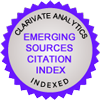Investigation of aging of bio-based and fossil-derived disposable plastic waste in different environmental media
Şevval Ürkmez, Meral YurtseverSakarya University, Faculty of Engineering, Environmental Engineering Department, 54187, Sakarya, Türkiye.Petroleum-derived plastic materials are widely used in many fields such as packaging, textiles, construction, automotive, electronics, medicine and agriculture. The wastes of these plastics used can cause various negative effects on the environment and living things. Due to overuse, plastics are found in almost every compartment of the environment and plastics can remain intact in nature for centuries due to their extreme durability. In addition, the penetration of plastic particles formed by the aging of plastics into living things is one of the important risks posed by plastics in the environment. To reduce the negative effects of conventional (petroleum-derived) plastics, the use of biodegradable plastics (bioplastics), which can decompose in nature in a short time, is being tried to be widespread as an alternative. However, regardless of whether it is biodegradable or conventional, the short or long-term degradation processes of plastic materials containing many additives in nature are still unclear. In this study, the deterioration processes of petroleum-derived plastics such as polyethylene (PE), polypropylene (PP), polystyrene (PS) and expanded polystyrene (EPS) and biodegradable polymer disposable plastics such as polylactic acid (PLA) were followed for one year. Thanks to the studies carried out in freshwater, saltwater and soil environments around Sakarya province, it was aimed to reveal the early term changes of plastic materials. In this study, surface and structural changes of plastic materials placed in different natural environments were analyzed and evaluated. Optical microscope and SEM (Scanning Electron Microscope) were used for microscopic investigations and ATR-FTIR (Attenuated Total Reflectance-Fourier Transform Infrared) was used for spectroscopic investigations. The carbonyl index (CI) of the polymers was calculated using ATR-FTIR data and the degree of degradation of the plastics was evaluated. While the findings show how plastic wastes change in different natural environments in the short term, they also provide essential data to simulate the long-term fate of these wastes.
Keywords: Bioplastics, Water resources, Soil, Environmental deterioration, Carbonyl index, SustainabilityBiyo-bazlı ve fosil kaynaklı tek kullanımlık plastik atıkların farklı çevresel ortamlardaki eskimesinin incelenmesi
Şevval Ürkmez, Meral YurtseverSakarya Üniversitesi, Mühendislik Fakültesi, Çevre Mühendisliği Bölümü, 54187, Sakarya, Türkiye.Petrol türevi plastik malzemeler, ambalaj, tekstil, inşaat, otomotiv, elektronik, tıp ve tarım gibi birçok alanda yaygın olarak kullanılmaktadır. Kullanılan bu plastiklerin atıkları çevre ve canlılar üzerinde çeşitli olumsuz etkilere yol açabilmektedir. Aşırı kullanım nedeniyle plastiklere neredeyse çevrenin her kompartmanında rastlanmakta ve son derece dayanıklı olmaları sebebiyle plastikler doğada yüzyıllarca bozulmadan kalabilmektedir. Ayrıca plastiklerin eskimesi ile oluşan plastik parçacıklarının canlılara nüfuz edebilmesi de plastiklerin çevrede yarattığı önemli risklerdendir. Geleneksel (petrol türevi) plastiklerin olumsuz etkilerini azaltmak amacıyla alternatif olarak, doğada kısa sürede ayrışabilen, biyobozunur plastiklerin (biyoplastikler) kullanımı yaygınlaştırılmaya çalışılmaktadır. Ancak, biyobozunur ya da konvansiyonel olması farketmeksizin içeriğinde bir çok katkı ihtiva eden plastik malzemelerin doğada kısa veya uzun vadede ayrışma süreçleri hala belirsizdir. Bu çalışmada, polietilen (PE), polipropilen (PP), polistiren (PS) ve genleştirilmiş polistiren (EPS) gibi petrol türevi plastiklerle polilaktik asit (PLA) gibi biyobozunur polimer yapısındaki tek kullanımlık plastiklerin değişim süreçleri, bir yıl boyunca takip edilmiştir. Sakarya ili çevresindeki tatlı su, tuzlu su ve toprak ortamlarında gerçekleştirilen çalışmalar sayesinde plastik malzemelerin erken dönemdeki değişiminin ortaya konulması amaçlanmıştır. Çalışmada farklı doğal ortamlara yerleştirilen plastik malzemelerin yüzeysel ve yapısal değişiklikleri incelenerek değerlendirilmiştir. Mikroskobik incelemelerde optik mikroskop ve SEM (Taramalı Elektron Mikroskobu), spektroskopik incelemelerde ise ATR-FTIR (Zayıflatılmış Toplam Yansıma-Fourier Dönüşümü Kızılötesi) kullanılmıştır. ATR-FTIR verileri kullanılarak polimerlerin karbonil indeksi (CI) hesaplamaları yapılmış ve plastiklerin bozunma dereceleri değerlendirilmiştir. Elde edilen veriler, plastik atıkların farklı doğal ortamlarda kısa dönemde nasıl bir değişim gösterdiğine ve uzun vadedeki kaderini simüle etmeye yönelik önemli bilgiler sağlamaktadır.
Anahtar Kelimeler: Biyoplastikler, Su kaynakları, Toprak, Çevresel bozunma, Karbonil indeksi, Sürdürülebilirlik.Manuscript Language: Turkish





